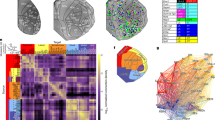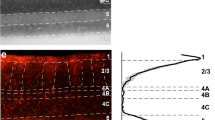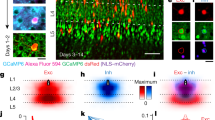Abstract
The many distinct cortical areas of the macaque monkey visual system can be arranged hierarchically, but not in a unique way. We suggest that the connections between these cortical areas never form strong, directed loops. For connections between the visual cortex and particular thalamic nuclei, we predict that certain types of connections will not be found. If strong, directed loops were to exist, we suggest that the cortex would go into uncontrolled oscillations.
This is a preview of subscription content, access via your institution
Access options
Subscribe to this journal
Receive 51 print issues and online access
$199.00 per year
only $3.90 per issue
Buy this article
- Purchase on Springer Link
- Instant access to full article PDF
Prices may be subject to local taxes which are calculated during checkout






Similar content being viewed by others
References
Felleman, D. J. & Van Essen, D. C. Distributed hierarchical processing in the primate cerebral cortex. Cereb. Cortex 1, 1–47 ( 1991).
Rockland, K. S. & Pandya, D. N. Laminar origins and terminations of cortical connections of the occipital lobe in the rhesus monkey. Brain Res. 179, 3– 20 (1979).
Hilgetag, C.-C., O'Neill, M. A. & Young, M. P. Indeterminate organization of the visual system. Science 271, 776–777 (1996).
Robinson, D. F. & Foulds, L. R. Digraphs: Theory and Techniques (Gordon and Breach, New York, (1980)).
Van Essen, D. C. & Felleman, D. J. On hierarchies (response to Hilgetag et al.). Science 271, 777 (1996).
Gutierrez, C., Yaun, A. & Cusick, C. G. Neurochemical subdivisions of the inferior pulvinar in macaque monkeys. J. Comp. Neurol. 363, 545–562 (1995).
Robinson, D. L. & Cowie, R. J. in Thalamus, 2: Experimental and Clinical Studies (eds Steriade, M., Jones, E. G. & McCormick, D. A.) (Elsevier, Amsterdam, in the press).
Mathers, L. H. Ultrastructure of the pulvinar of the squirrel monkey. J. Comp. Neurol. 146, 15–42 ( 1972).
Mathers, L. H. The synaptic organization of the cortical projection to the pulvinar of the squirrel monkey. J. Comp. Neurol. 146, 43 –60 (1972).
Ojima, H. Terminal morphology and distribution of corticothalamic fibers originating from layers 5 and 6 of cat primary auditory cortex. Cereb. Cortex 6, 646–663 ( 1994).
Rockland, K. S. Further evidence for two types of corticopulvinar neurons. NeuroReport 5, 1865–1868 ( 1994).
Rockland, K. S. Two types of corticopulvinar terminations: round (type 2) and elongate (type 1). J. Comp. Neurol. 368, 57– 87 (1996).
Bourassa, J., Deschênes, M. Corticothalamic projections from the primary visual cortex in rats: a single fiber study using biocytin as an anterograde tracer. Neuroscience 66, 253–263 (1995).
Guillery, R. W. Anatomical evidence concerning the role of the thalamus in corticocortical communication: a brief review. J. Anat. 187, 583–592 (1995).
Sherman, S. M. & Guillery, R. W. Functional organization of thalamocortical relays. J. Neurophys. 76, 1367–1395 (1996).
Guillery, R. W. Patterns of synaptic interconnections in the dorsal lateral geniculate nucleus of the cat and monkey: a brief review. Vision Res. 3, 211–227 (1971).
Kalil, R. E. & Chase, R. Corticofugal influence on activity of lateral geniculate neurons in the cat. J. Neurophysiol. 33, 459–474 (1970).
Baker, F. H. & Malpeli, J. G. Effects of cryogenic blockade of visual cortex on the responses of lateral geniculate neurons in the monkey. Exp. Brain Res. 29, 433– 444 (1977).
Sillito, A. M., Jones, H. E., Gerstein, G. L. & West, D. C. Feature-linked synchronization of thalamic relay cell firing induced by feedback from the visual cortex. Nature 369, 479– 482 (1994).
Callaway, E. M. Local circuits in primary visual cortex of the macaque monkey. Annu. Rev. Neurosci.(in the press).
Rockland, K. S. Convergence and branching patterns of round, type 2 corticopulvinar axons. J. Comp. Neurol.(in the press).
Peters, A., Payne, B. R. & Budd, J. Anumerical analysis of the geniculocortical input to striate cortex in the monkey. Cereb. Cortex 4, 215–229 (1994).
Hendry, S. H. C. & Yoshioka, T. Aneurochemically distinct third channel in the macaque dorsal lateral geniculate nucleus. Science 264, 575–577 ( 1994).
Jones, E. G. The Thalamus (Plenum, New York, (1985)).
Levitt, J. B., Yoshioka, T. & Lund, J. S. Connections between the pulvinar complex and cytochrome oxidase-defined compartments in visual area V2 of macaque monkey. Exp. Brain Res. 104, 419–430 (1995).
Hirsch, M. W. Convergent activation dynamics in continuous time networks. Neural Networks 2, 331–349 ( 1989).
Kuan, C.-M., Hornik, K. & White, H. Aconvergence result for learning in recurrent neural networks. Neural Comp. 6, 420–440 (1994).
Sandell, J. H. & Schiller, P. H. Effect of cooling area 18 on striate cortex cells in the squirrel monkey. J. Neurophys. 48, 38–48 (1982).
Mignard, M. & Malpeli, J. G. Paths of information flow through visual cortex. Science 251, 1249– 1251 (1991).
Salin, P.-A. & Bullier, J. Corticocortical connections in the visual system: structure and function. Physiol. Rev. 75, 107–154 (1995).
Crick, F. & Koch, C. Are we aware of neural activity in primary visual cortex? Nature 375, 121– 123 (1995).
Webster, M. J., Bachevalier, J. & Ungerleider, L. G. Connections of inferior temporal areas TEO and TE with parietal and frontal cortex in macaque monkeys. Cereb. Cortex 5, 470–483 ( 1994).
Douglas, R., Koch, C., Mahowald, M., Martin, K. & Suarez, H. Recurrent excitation in neocortical circuits. Science 269, 981–985 ( 1995).
Lisman, J. E. Bursts as a unit of neural information: making unreliable synapses reliable. Trends Neurosci. 20, 38– 43 (1997).
Acknowledgements
F.C. is supported by the J. W. Kieckhefer Foundation. C.K. is supported by the National Institute of Mental Health, the Office of Naval Research and the National Science Foundation. Especial thanks to Jan Kaas and Kathy Rockland.
Author information
Authors and Affiliations
Rights and permissions
About this article
Cite this article
Crick, F., Koch, C. Constraints on cortical and thalamic projections: the no-strong-loops hypothesis. Nature 391, 245–250 (1998). https://doi.org/10.1038/34584
Received:
Accepted:
Issue Date:
DOI: https://doi.org/10.1038/34584
This article is cited by
-
Meeting report for the 2022 UC Irvine Center for neural circuit mapping conference: linking brain function to cell types and circuits
Molecular Psychiatry (2023)
-
Canonical circuit computations for computer vision
Biological Cybernetics (2023)
-
Cortical traveling waves reflect state-dependent hierarchical sequencing of local regions in the human connectome network
Scientific Reports (2022)
-
Anatomical and functional connectomes underlying hierarchical visual processing in mouse visual system
Brain Structure and Function (2022)
-
High-order coordination of cortical spiking activity modulates perceptual accuracy
Nature Neuroscience (2019)
Comments
By submitting a comment you agree to abide by our Terms and Community Guidelines. If you find something abusive or that does not comply with our terms or guidelines please flag it as inappropriate.



